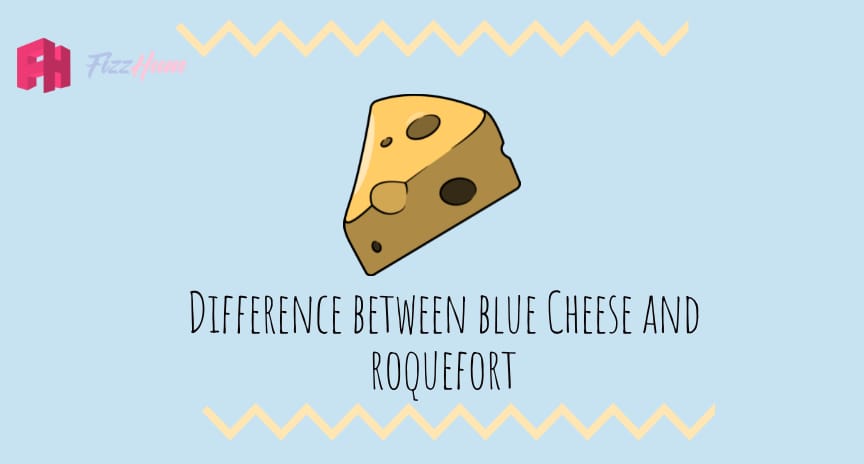- Home
- Difference between Blue cheese and Roquefort
Difference between Blue cheese and Roquefort
Introduction:
Dairy products are made from milk. Dairy products can be made from cow, buffalo, camel, sheep, and goat milk and even in some parts of the world with reindeer and yaks milk. Cheese is a dairy product commonly used in the world. The word cheese is originally generated from the Latin word “Caseum”. Earlier cheese was used to be very salty but as time passes it becomes creamier and less salty. The first cheese factory was assembled in Switzerland in 1815. Although it was first discovered in the Middle East around 8000 BC. Cheese is made when the milk is expired or old and bacteria grows rapidly in the milk and digest the lactose in milk, producing lactic acid as a result. Lactic acid causes curdle in milk and give the milk a sour smell.
.jpeg)
In this article, we will put some light on the salient features of Blue cheese and Roquefort along with their difference in them. Although Roquefort is a type of Blue Cheese we will try to differentiate as much as possible.
Blue Cheese:
Nowadays mostly cheese is made in factories with the modern procedure. Milk is poured into big vats, a starter culture of bacteria is mixed with milk to convert lactose into lactic acid. Then an enzyme is added to curdle the milk, an enzyme is also known as rennet. In the early days, rennet was obtained from the stomach of young cows or veal but now cheesemaker gets it in the shape of bacteria or yeast to make the enzyme. The whey is then removed and salt is added.
Blue Cheese is soft and creamy in texture with a sharp or piquant flavor. It is often salty but not over salty to avoid bitterness. The taste of cheese depends on many factors like which animal milk is used. It is the type of cheese that has bluish or greenish veins in it. It is a dairy product made from cow milk. It is made by separating whey and curd and some of the whey is kept with curd for fermenting process. The fermenting process of blue cheese is different from other cheese because it is not homogenized or pasteurized rather a mold is introduced in curd or milk and then it is salted or stoned and then kept for 2 to 3 months or longer. It is believed that the first blue cheese was discovered by accident when cheese used to be stored in the cave with naturally controlled temperature which happens to be favorable for many varieties of bacteria. Following are some varieties of Blue Cheese
- French Roquefort (France)
- English Stilton (England)
- Italian Gorgonzola (Italy)
- Danablu (Denmark)
- Blue Cheshire (England)
- Bleu de Breese (France)
.jpeg)
Roquefort:
Roquefort is a type of blue cheese with some different characteristics. The taste of Roquefort is bold, sharp, and salty. Due to its mouthwatering taste, it is only made in France. It is mostly used for salad topping and dressing. It was first discovered by an accident in the limestone cave of Roquefort, France. Where a boy was eating a loaf of bread with ewe milk abandoned his meal when he saw a beautiful girl after someday when he returns to the cave his ewe milk was changed into cheese by bacteria. After that, it was called the name of Roquefort cave. It is one of the greatest cheeses in France and the right of Roquefort cheese is saved by France. There are Roquefort made in Corsica but in the end, they all have to undergo final aging at the limestone cave of Roquefort. Where the natural temperature promotes the growth of mold. Roquefort is formed in a 2 to 3 kg cylinder which is 18 cm in diameter and its thickness is 4 inches. The paste is wrapped in the foil with the traditional logo of red sheep on it
According to French law, only cheese processed in the limestone cave of Roquefort will be labeled as “Roquefort cheese”, on the other hand, other cheeses processed in France are labeled as “bleu cheese”. According to France media report, 75 percent of feeding material for sheep producing milk for Roquefort are farmed in France and the sheep that are not fed the special diet are not eligible for Roquefort cheese.
.jpeg)
Difference between Blue cheese and Roquefort
|
Features |
Blue Cheese |
Roquefort |
|
|
|
|
|
Taste |
Slightly salty taste |
Sharp and salty taste |
|
|
|
|
|
Texture |
Soft, creamy, crumbly |
White, tangy, crumbly |
|
|
|
|
|
Procedure |
Modern procedure |
Modern techniques with the old procedure |
|
|
|
|
|
Milk |
Cow milk |
Ewe milk |
|
|
|
|
.jpeg)
Conclusion:
In this article, we have seen some features of both dairy products. Some similarities and differences between Blue cheese and Roquefort are also discussed above. Hopefully, after reading this article the reader will have clear in mind the difference between the two same categories of cheese and which one to choose to enjoy the meal.



.png)

What other's say about : How ThePhone thriller..